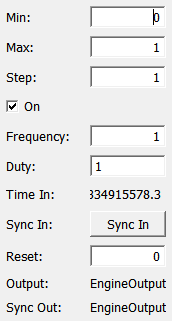SoTimeCounter¶
-
InventorModule¶ genre InventorEnginesauthor Silicon Graphics Incpackage MeVisLab/Standarddefinition inventor.def
Purpose¶
This engine is a counter that outputs numbers, starting at a minimum value, increasing by a step value, and ending with a number that does not exceed the maximum value. When the maximum number is reached, it starts counting from the beginning again.
The difference between this engine and the SoCounter engine, is that this engine also has a Time In input, which allows the counting cycles to be timed. This engine counts automatically over time; it does not need to be triggered to go to the next step. By default, the Time In input is connected to the realTime global field. It can, however, be connected to any time source.
The frequency input field controls how many min-to-max cycles are performed per second. For example, a frequency value of 0.5 means that it will take 2 seconds to complete a single min-to-max cycle. The steps in the count cycle do not necessarily all have the same duration. Using the duty input field, you can arbitrarily split the time period of the count cycle between the steps. For example, if there are 5 steps in the cycle, a duty input of (1., 2., 2., 2., 1.) will make the second, third, and fourth steps take twice as long as the first and last steps.
At any time the counter can be reset to a specific value. If you set the reset input field to a value, the engine will continue counting from there. Note that the counter will always output numbers based on the min, max and step values, and setting the reset value does not affect the those input fields. If the reset value is not a legal counter value, the counter will still behave as though it is:
- If reset is greater than max, the counter is set to max.
- If reset is less than min, the counter is set to min.
- If reset is between step values, the counter is set to the lower step.
Each time a counting cycle is started, the Sync Out output is triggered. This output can be used to synchronize some other event with the counting cycle. Other events can also synchronize the counter by triggering the Sync In input.
You can pause the engine, by setting the on input to FALSE, and it will stop updating the output field. When you turn off the pause, by setting on to TRUE, it will start counting again from where it left off.
